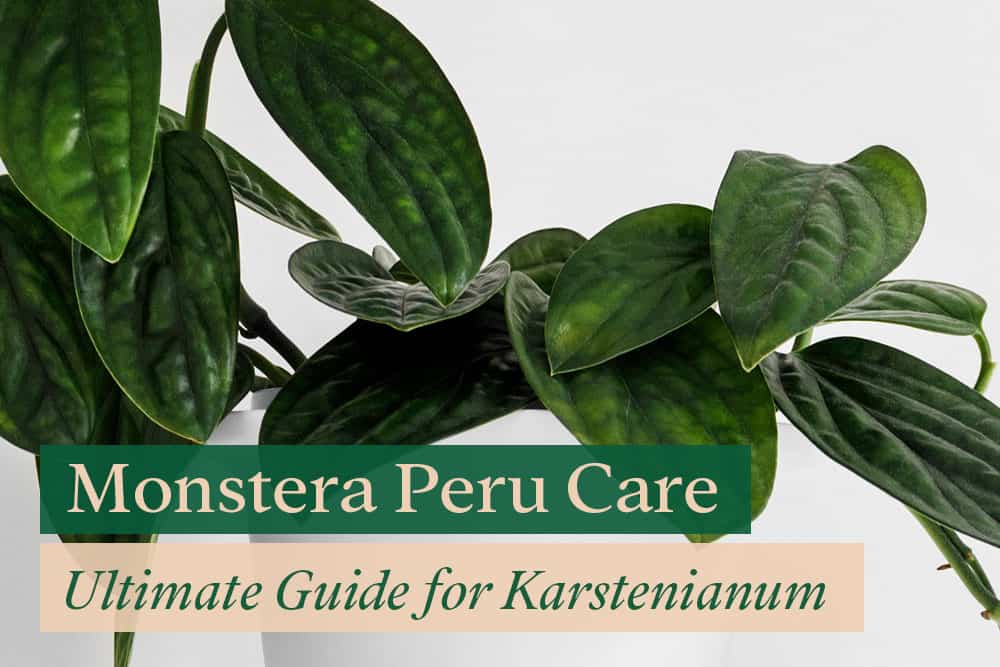
Do you have a Monstera Peru in your collection? Or are you considering buying one and wondering how hard is it to maintain the Karstenianum plant?
You should water Monstera Peru once a week, give it plenty of bright, indirect sunlight exposure, and maintain room temperature between 65° and 80°F. Maintain a humidity level of at least 50%, and make sure to introduce a moss pole for vertical support.
In this in-depth article, you’ll not only how to care for it properly, but you will also learn how to identify and fix common problems that often come up.
Before we start,
Fun Facts about Monstera Peru
Unlike Monstera Deliciosa and Adansonii, Monstera Peru does not have fenestration on its leaves. Its glossy, deep green leaves are thick, stiff, and have a dragon-scale texture to them.
Is Monstera Peru rare?
Although Monstera Peru is such a fast grower, it is a rare plant–you are unlikely to find them in your local nursery.
Some sellers in Etsy sell cuttings of Monstera Peru with 4 to 5 leaves for $40 to $60!
Monstera Peru Growth Habit
As a natural climber, Monstera Peru needs vertical support such as a moss pole to grow faster and bigger. In just six months, my Karstenianum has grown past its 1-meter pole. I need to prune them regularly to avoid a messy look.
Their aerial roots are not deeply rooted, but I always find it difficult to pluck the rooted leaves from the moss pole when pruned.
Toxicity
Like M.Deliciosa, Monstera Peru contains calcium oxalate crystals that can irritate the mouth and tongue and difficulty swallowing if ingested by pets or children.
Check out my article on how to kid-proof your Monstera plants.
Variegation
Although I have never seen an actual Monstera Peru Variegata, there is a variegated version of this tropical plant.
Unlike Monstera Deliciosa, Monstera Peru only has two variegation colors: Aurea (Yellow) and Sport (Green). The variegation also exists in both sectoral and marble patterns.
Also read: Variegated Monstera: Everything You Need to Know
Monstera Peru Care Basics
Now, it’s time to check out how to give your Monstera Peru the best care possible.
Lighting
Monstera Peru thrives best in bright, indirect sunlight from a filtered south-facing window.
I place the plant at least a few feet away from the window, and I use a sheer curtain to filter intense direct sunlight. If you want to put it outdoors, make sure to give it enough shade, so the leaves do not burn.
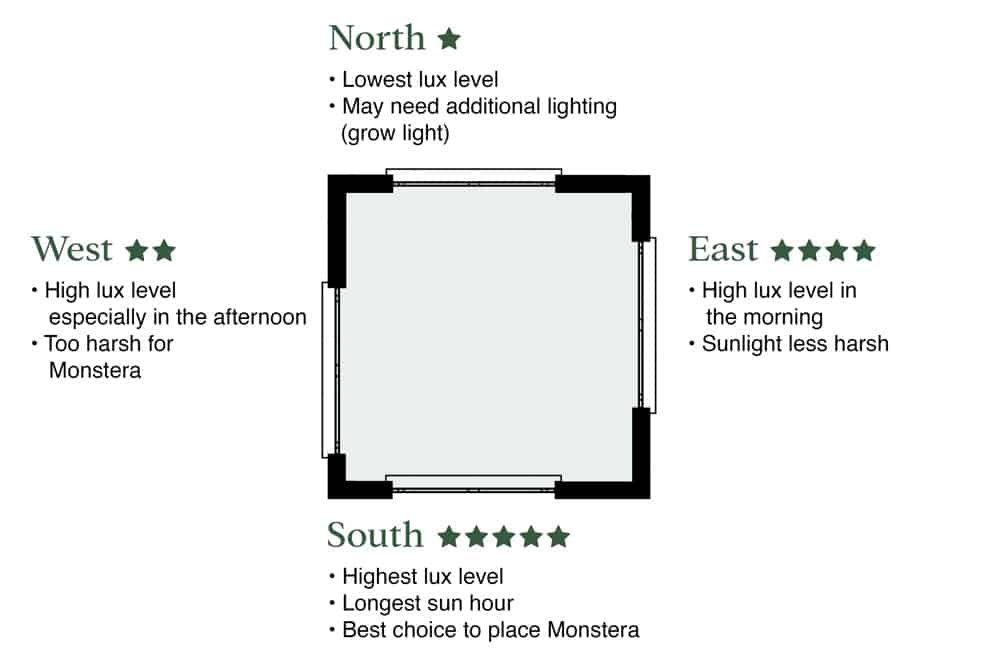
Under very low light conditions, your Monstera Karstenianum will become leggy, and leaves may turn yellow from overwatering. To help it flourish in areas with sparse sunlight, install a grow light to provide additional light.
Watering
Generally, Monstera Peru needs moderate watering once a week. Make sure the topsoil has dried up between waterings to avoid overwatering.
I always use rainwater or distilled water, as my tap water has too much chlorine, which leads to salt buildup over time and may cause my plants to become dehydrated.
Read more about the best practices on how to water your Monstera Peru.
Soil Mixture
Monstera Peru thrives in aerated, well-draining potting soil. The proper soil should allow water to drain quickly and avoid roots sitting in excess moisture, leading to root rot.
I use a mixture of pine bark, perlite, coconut coir, activated charcoal, and worm casting to make my soil mix. If you want to avoid the hassle, consider adding perlite into store-bought potting soil to enhance drainage.
Temperature & Humidity
The Monstera Peru prefers a space with an ambient temperature between 60°F and 80°F (16°C to 27°C) and humidity levels of at least 60%.
Heat stress and dry air cause plants to lose water in two significant ways: transpiration from the leaves and moisture evaporation from the soil.
When excess water is lost, your Monstera Peru will activate its defense system and curl its leaves to reduce further moisture loss.
I usually turn on both my heater and plant humidifier or use a pebble tray in the winter months to maintain its ideal temperature and humidity.
Fertilizer
During its growing season in Summer and Spring, you will need to use fertilizer to provide extra nutrients for Monstera Peru once every 2 to 4 weeks.
I prefer using a liquid fertilizer with a 5-2-3 NPK ratio, as I find that fertilizer heavy in Nitrogen helps promote fuller foliage. But you can always use a fertilizer with a balanced NPK ratio as well.
Also, note that you should consider always using half the strength of your fertilizer dose by diluting it in water to reduce the possibility of root burn.
Read more: Fertilizer Guide for Monstera Plant
Pot Requirement
When choosing a pot for your Monstera Peru, make sure that your pot has a drainage hole to allow water to drain out during watering.
Consider your watering habit as you select the pot for your Monstera Peru. If you tend to overwater your plants, getting terracotta pots could help the water to evaporate faster. Conversely, ceramic and plastic pots require less routine watering as they retain moisture.
In any case, you should not pot new cutting in an oversized pot as its root is not developed enough to reach the water retained on the edges of it. Soil left wet for too long will encourage bacteria growth that can lead to root rot.
Repotting
It would be best if you considered repotting your Monstera Peru every two years or when you start seeing roots coming out of the drainage hole. It is common for their roots to wrap around the pot and become rootbound.
A rootbound Monstera Peru may suffer from dehydration and nutrient deficiency as the plant’s roots cannot take in water or nutrients from the soil.
When repotting, always get a pot that’s two inches larger in diameter and find taller vertical support for it to climb.
Hang Down vs Let it Climb
As a vining plant, Monstera Peru can be grown in two ways: either hang down or be supported to climb.
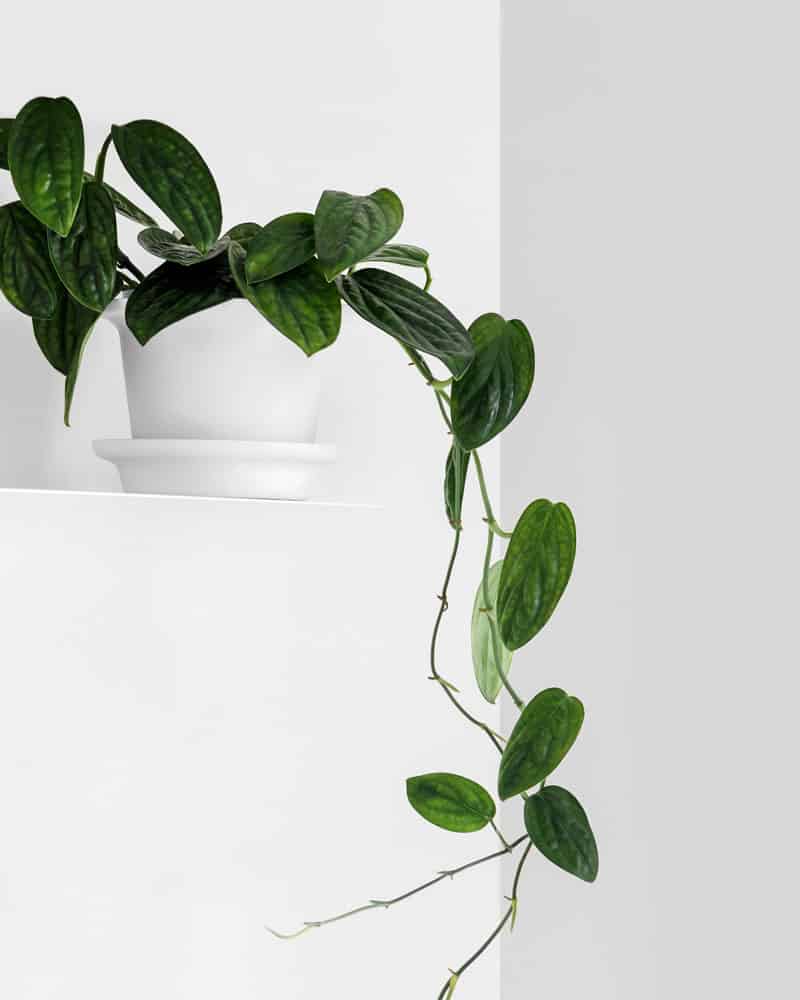
Frankly, I have only seen Monstera Peru hang down on the internet, but they look gorgeous! Consider placing it in a hanging pot for an attractive display on your patio.
However, I enjoy the growth of leaves being vertical. That is why it is essential to install a moss pole or totem.
Cleaning Requirement
I find that the Monstera Peru is one of the world’s dustiest plants. This may be due to its corrugated texture which traps dust easily.
Regularly cleaning the leaves of your Monstera Plant will get rid of dust away from the stomata and allow for optimal photosynthesis that promotes growth. This routine will also allow you to identify and remove pests early.
Use a clean damp cloth to wipe both sides of the leaves. Place your hand on the opposite side of the leaves while you wipe another to avoid damaging them.
You should finish off your routine by spraying neem oil on the plant to protect it from insects.
Pruning
As I mentioned earlier, Monstera Peru is a very fast grower. Check out how mine looks after its last pruning:
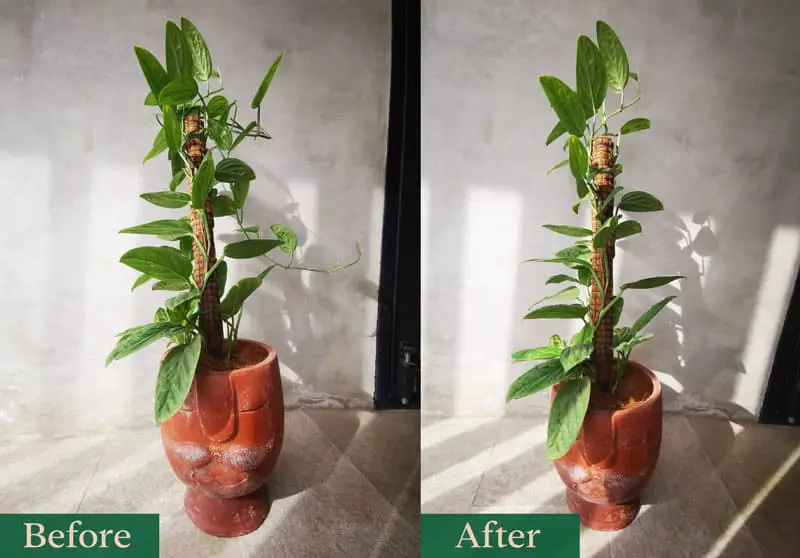
I schedule my Monstera Peru pruning at least once every three months or when I feel that the look is already too messy.
When you’re pruning, make sure to identify and remove any leaves that are sick or dying. This will allow the plant more room for healthy leaves to thrive.
Pruning should always be done just above the leaf node to allow your plant to continue growing. The only time you want to cut below the node is when propagating it.
Propagation
Let me tell you a secret. You can always give your propagated Monstera Peru as a unique one-of-a-kind gift to any friend or relative. Who knows, you can turn them into avid plant parents as well!
Propagating a Monstera Peru is a straightforward process. Cut the stem with at least two foliage and leave the node intact.
Next, you can either root the cuttings in water or directly into the soil. The roots should start to develop in about a month.
Also read: Can You Propagate Monstera Without Node?
Common Problems
Look, caring for plants is not always perfect, and you’ll face problems along the way. You need to be able to identify the root cause of these problems quickly to fix them.
Here is a list of common problems you might encounter with Monstera Peru.
Crispy brown leaves
If your Monstera Peru leaves are crispy and light brown, it is most likely because the plant isn’t receiving enough water.
To determine if a plant is underwatered, check the soil with your finger or measure the moisture level with a soil meter. If it’s dry, give it heavy watering and let the water drain out of the pot.
Remember, remove the damaged leaves to allow healthy leaves to receive more water and nutrients.
Leaves are curling
Monstera Peru leaves curling in response to dehydration to avoid further water loss through transpiration.
While underwatering can cause this, other underlying conditions such as high temperature and humidity can also contribute to leaves curl.
Yellowing on the leaves
Yellowing Monstera Peru leaves can indicate many different problems.
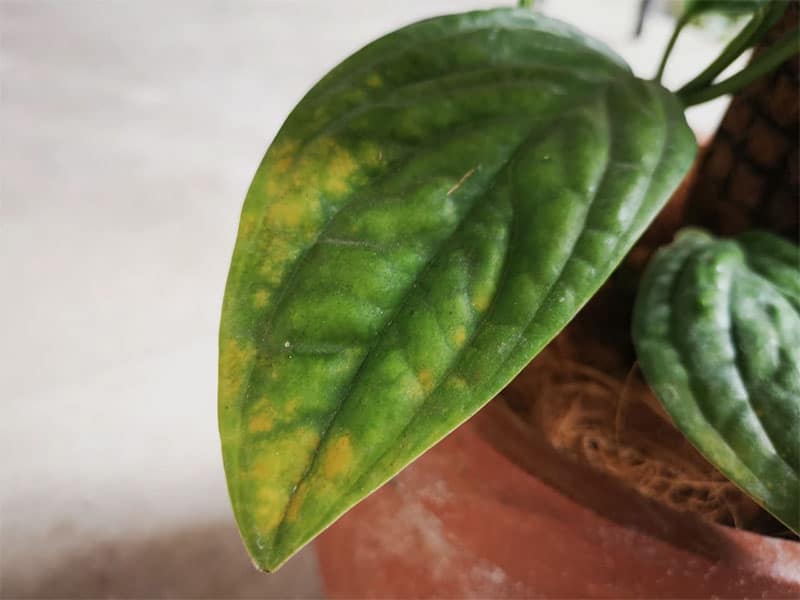
If the yellowing is only visible at the edges of the leaves, it’s most likely due to a lack of nutrients.
Yellowing and droopy leaves, on the other hand, can tell you that your plant is underwatered.
When exposed to direct sunlight, Monstera Peru leaves will turn yellow as well with burnt black marks.
Some of the leaves at the bottom of a plant may turn yellow even if there’s nothing wrong. This yellowing is just a natural thing that happens to plants where they shed old leaves that are no longer productive.
Pest Infestation
Three pests that commonly cause damage to Monstera Peru are spider mites, brown scale and mealybugs.
These insects feed on the sap that helps carry water and nutrients around the plant, thus affecting the photosynthesis process.
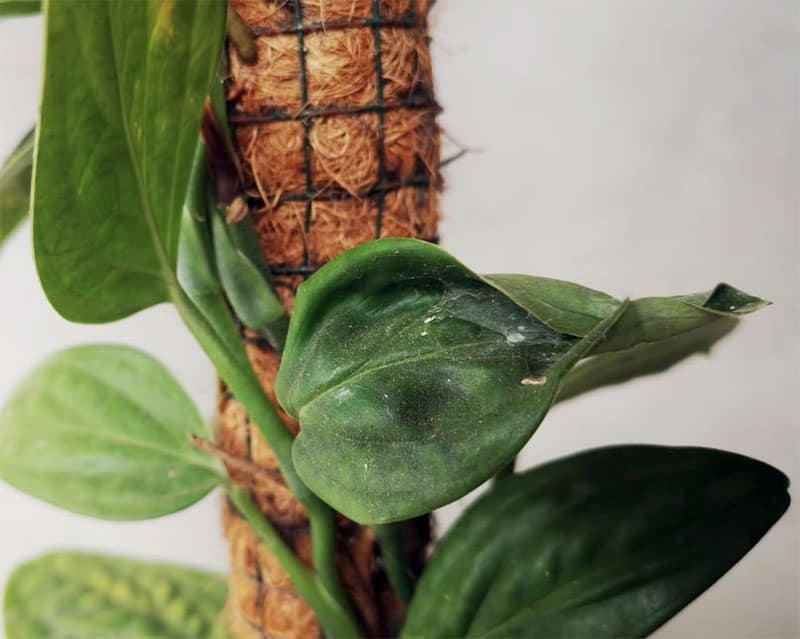
To get rid of these pests off your plant, apply isopropyl alcohol diluted with water onto cotton swabs and wipe them on the infected area. In cases of heavily infested areas, the best option is to use insecticidal soap, which is an all-natural pesticide.
In Conclusion
Monstera Peru is one of my most exotic-looking and unique plants. They are fast-growing and easy to care.
If you are interested to know more about Monstera, you can check out other varieties of Monstera on this blog.
